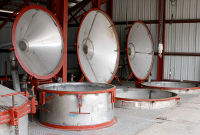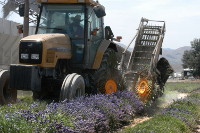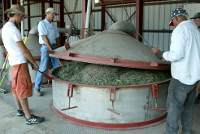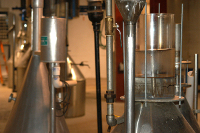Essential Oil Distillation
How are essential oils made?
Essential oils can be extracted from a plant in a variety of ways. These include expressing the oils with pressure, extracting them with a solvent, or using an essential oil distiller.
The highest quality oils are obtained through a process of steam distillation... and proper essential oil distillation is critical when it comes to assuring the quality of a therapeutic grade oil.
This may seem like a dull subject – but it's so important when it comes to producing an essential oil that maintains its therapeutic benefits.

Steam Distillation
Steam distillation has been practiced for centuries. It can be a very effective way for extracting quality essential oils, and it's commonly used today.
Although methods of distilling essential oils can differ a bit, they all follow the same basic principle.
As steam increases, it ruptures the oil membranes of a plant and this releases its essential oil. The steam carries the oil up through a condenser, where the mixture of oil and steam re-liquifies. As the steam condenses back into water, the distilled essential oil gathers on top of it.

Factors Affecting Essential Oil Distillation
There are a number of factors that come into play in the process of distilling essential oils...
The first of these is the quality of the raw plant material being distilled.
The production of essential oils take a lot of raw plant material. For example, it takes 5,000 pounds of fresh rose petals to produce one pint of rose oil!
Essential oils of a trusted therapeutic grade can only be obtained by starting with plants that have grown in uncontaminated, mineral-rich soil with a pure source of water.
So you have to appreciate what it takes to get the raw material needed for essential oils, before you even start distilling.
Other significant factors producing quality essential oils include things such as: the timing of the harvest, dew, the number of blooms, and the weather.
The size and material of the cooking chamber of an essential oil distiller, as well as the type of condenser and separator, affect the purity of an essential oil as well.
And the cooking temperature and pressure used in essential oil distillation are extremely important.

Temperature and Pressure
The highest quality essential oils take time to distill, because they are extracted with lower temperatures and pressures.
It's possible to extract an essential oil quicker using higher pressures and temperatures – and this is often done – but doing so alters the properties of the oil and diminishes its therapeutic properties.
Take cypress as an example.
According to the Essential Oils Desk Reference, “cypress requires a minimum of 24 hours distillation at 265° F and 5 pounds of pressure to extract most of the therapeutically-active constituents. If distillation time is cut by only two hours, 18 to 20 constituents will be missing from the resulting oil.”
Further, “most commercial cypress oil is distilled for only 2 hours and 15 minutes! This short distillation time allows the producer to cut cost and produces a cheaper oil... Sadly, it results in an oil with little or no therapeutic value."

Preserving Therapeutic Benefits
It needs to be remembered that essential oils are comprised of chemically complex parts. Maintaining the integrity of these structures is indispensable to preserving the therapeutic benefits of an essential oil.
For this preservation to take place, careful and patient attention must be given to the whole distillation process. Shortcuts only diminish or remove the therapeutic value of the oil.
By far, the majority of essential oils produced today are for the perfume industry. This industry is able to produce a high volume of aromatic oils using high pressure, high temperatures, and chemical solvents because it is not aiming for therapeutic benefits.
Those who desire oils with therapeutic benefits, however, must be assured that the oils they possess have been extracted with a superior essential oil distillation process.
Once you understand this process, you can appreciate the difference.
For more on what it takes to make quality, therapeutic essential oils, visit my 'Seed to Seal' page.
Return from Essential Oil Distillation to Therapeutic Essential Oils
Return from Essential Oil Distillation to Family Essential Oils HOME



